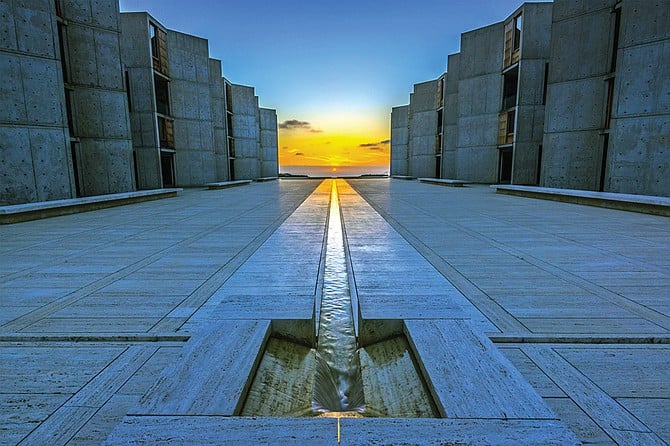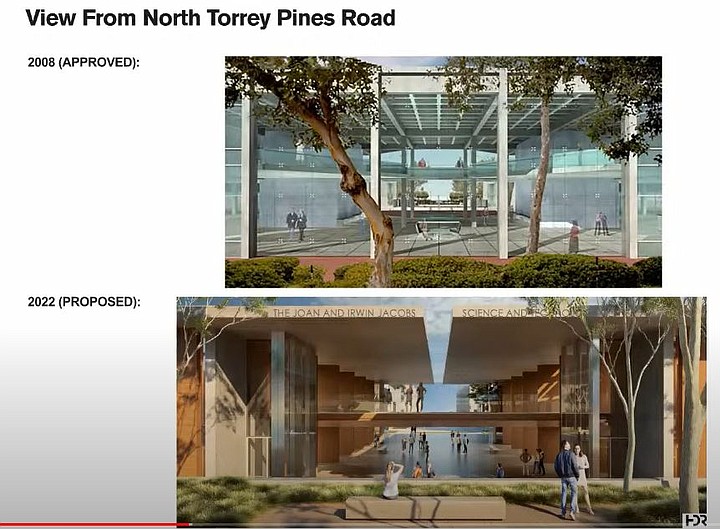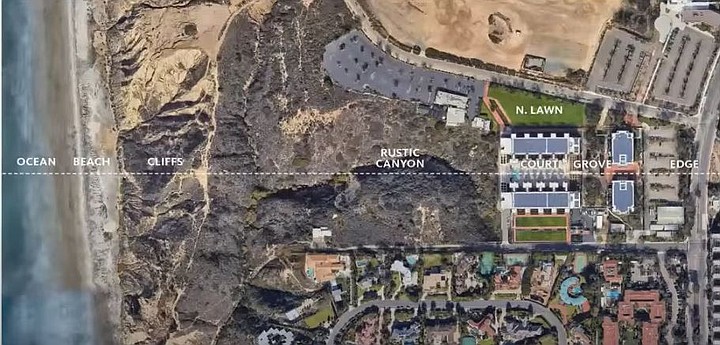 Facebook
Facebook
 X
X
 Instagram
Instagram
 TikTok
TikTok
 Youtube
Youtube

A dispute over an addition to the Salk Institute in La Jolla has ended. Last week, the Planning Commission denied an appeal claiming the proposed design ruins the historic integrity of the East Torrey Pines building.
It’s like installing a two-story-high picket fence around Stonehenge, as one critic put it.

Not everyone agreed, but no one disagreed that the famous research center, designed by architect Louis Kahn and first approved in 1961, is historically important, even though it has not been listed on the National Register of Historic Places.
"My objection is not to the research wings, it's not to the landscaping," or the underground parking, said appellant and architect, Charles Kaminski.
The problem is the atrium, an open, interior, sky-lit court centered between two six-story buildings. It's not just a space to hold gatherings, or to connect the twin research structures. Photos from the original plans make clear the intent of Dr. Jonas Salk, developer of the polio vaccine, and architect Kahn, Kaminski said.

"That the continent of the U.S. would flow through the site, out to the sky and to the ocean."
This east-west axis is the most important element in any design, he added, and it's been hacked by details that disrupt the amount of light and the linear view, like reduced glass.
"What was once described as limited visibility has now become invisible."
The first buildings of the Institute were completed in 1965, and it has kept growing ever since, through seven amendments. Most recent was the current project's approval by the city council in 2008 for the addition of the East Torrey Pines building.
Even then, concerns were raised that any new building must fully mitigate the loss of the linear and visual east-west connection of the continent to the sea and sky, Kaminski said. The approval said the proposed changes offered only "minimum mitigation."
A phased expansion of the institute allowed some facilities to move forward while providing detailed design guidelines and standards for development, a report says.
The proposed project, located at 10010 North Torrey Pines Road, increases the East Torrey Pines building from 94,200 to 97,140 square feet, while decreasing the future Salk Community Center. Changes will be made to the building's floor plans, exterior elevations and roof. as well as its access, parking and landscaping.
Applicant Tim Ball, director of facilities and planning for the Salk Institute, said the design conforms to the original approvals; in particular, the "secured central hall embedded in the heart of the building."
It's a space where "scientific collaboration and public interaction can flourish," he added. As the biotech grows, "we've reached our maximum capacity and need to press forward with our master plan buildout."
The appeal filed in January requests that the design changes and details be reviewed by the full Historic Resources Board. It claims inadequate oversight and lack of public comment.
According to the commission, a comprehensive review of the proposed project, which included review by historic resources staff, found it conforms with the development permit, and the U.S. Secretary of the Interior's standards, as well as the discretionary permit and mitigation approved in 2008.
With those findings, no additional oversight was required.
In 1991, the city of San Diego designated the institute as a local historic resource in its register of historic landmarks. And the state has deemed the entire 27-acre site eligible for the National Register of Historic Places.
Bruce Coons, executive director of the Save Our heritage Organization, supported the appeal.
"SOHO continues to strongly oppose the closed glass atrium design of the Torrey Pines east building and maintains it should follow Salk's precedent of two separate buildings with a wide open plaza."
Opposing the appeal, Sharon Yale called the view symbolic, saying which is more important, the Salk Institute's goals of doing research - or the idea of historic preservation?
"No one ever intended a real axial view cutting through the city of San Diego, from the ocean to the mountains, or Texas or something."


A dispute over an addition to the Salk Institute in La Jolla has ended. Last week, the Planning Commission denied an appeal claiming the proposed design ruins the historic integrity of the East Torrey Pines building.
It’s like installing a two-story-high picket fence around Stonehenge, as one critic put it.

Not everyone agreed, but no one disagreed that the famous research center, designed by architect Louis Kahn and first approved in 1961, is historically important, even though it has not been listed on the National Register of Historic Places.
"My objection is not to the research wings, it's not to the landscaping," or the underground parking, said appellant and architect, Charles Kaminski.
The problem is the atrium, an open, interior, sky-lit court centered between two six-story buildings. It's not just a space to hold gatherings, or to connect the twin research structures. Photos from the original plans make clear the intent of Dr. Jonas Salk, developer of the polio vaccine, and architect Kahn, Kaminski said.

"That the continent of the U.S. would flow through the site, out to the sky and to the ocean."
This east-west axis is the most important element in any design, he added, and it's been hacked by details that disrupt the amount of light and the linear view, like reduced glass.
"What was once described as limited visibility has now become invisible."
The first buildings of the Institute were completed in 1965, and it has kept growing ever since, through seven amendments. Most recent was the current project's approval by the city council in 2008 for the addition of the East Torrey Pines building.
Even then, concerns were raised that any new building must fully mitigate the loss of the linear and visual east-west connection of the continent to the sea and sky, Kaminski said. The approval said the proposed changes offered only "minimum mitigation."
A phased expansion of the institute allowed some facilities to move forward while providing detailed design guidelines and standards for development, a report says.
The proposed project, located at 10010 North Torrey Pines Road, increases the East Torrey Pines building from 94,200 to 97,140 square feet, while decreasing the future Salk Community Center. Changes will be made to the building's floor plans, exterior elevations and roof. as well as its access, parking and landscaping.
Applicant Tim Ball, director of facilities and planning for the Salk Institute, said the design conforms to the original approvals; in particular, the "secured central hall embedded in the heart of the building."
It's a space where "scientific collaboration and public interaction can flourish," he added. As the biotech grows, "we've reached our maximum capacity and need to press forward with our master plan buildout."
The appeal filed in January requests that the design changes and details be reviewed by the full Historic Resources Board. It claims inadequate oversight and lack of public comment.
According to the commission, a comprehensive review of the proposed project, which included review by historic resources staff, found it conforms with the development permit, and the U.S. Secretary of the Interior's standards, as well as the discretionary permit and mitigation approved in 2008.
With those findings, no additional oversight was required.
In 1991, the city of San Diego designated the institute as a local historic resource in its register of historic landmarks. And the state has deemed the entire 27-acre site eligible for the National Register of Historic Places.
Bruce Coons, executive director of the Save Our heritage Organization, supported the appeal.
"SOHO continues to strongly oppose the closed glass atrium design of the Torrey Pines east building and maintains it should follow Salk's precedent of two separate buildings with a wide open plaza."
Opposing the appeal, Sharon Yale called the view symbolic, saying which is more important, the Salk Institute's goals of doing research - or the idea of historic preservation?
"No one ever intended a real axial view cutting through the city of San Diego, from the ocean to the mountains, or Texas or something."
Comments